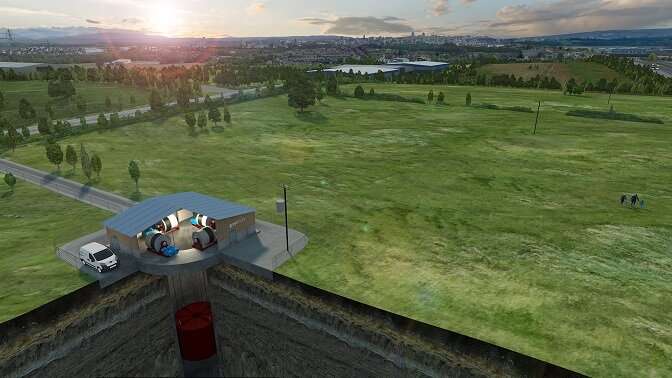September 7, 2020 report
Construction begins on energy storage system relying on gravity

Gravity has been the center of wonderment for physicists, mathematicians and thinkers of all kinds for centuries.
In the early 1600s, astronomer Galileo dropped balls from the Tower of Pisa and declared that gravitational acceleration is the same for all objects. Decades later, Isaac Newton expanded on those thoughts and devised his theory of gravity, that all particles attract all other particles with a force directly proportional to the square of the distance between their centers.
Philosopher Thomas Carlyle calculated, "It is a mathematical fact that the casting of a pebble from my hand alters the center of gravity of the universe." Cosmologist Stephen Hawking declared, "Because there is a law such as gravity, the universe can and will create itself from nothing."
And physicist Paul Dirac observed: "Pick a flower on Earth and you move the farthest star."
Last week, a British energy startup company placed its own stamp on the history of gravity by beginning construction of an energy storage system powered by—gravity.
As the company says on its web site: "Our patented technology is based on a simple principle: raising and lowering a heavy weight to store and release energy."
The company, Gravitricity, will manipulate massive weights in a tall shaft to store and deploy energy as needed. The shafts will rise nearly one mile high and the weights will range between 500 to 5,000 tons. Huge winches will raise and lower the weights, and the shafts will be pressurized to boost energy output.
According to Gravitricity officials, peak power generation can reach between 1 and 20 megawatts, with continuous output of up to eight hours. Maximum wattage power can be achieved in less than a second, officials say, making the system ideal as a back-up power solution.
Costs are lower than current energy storage systems, such as emerging lithium-ion battery solutions. Gravitricity officials say that unlike battery systems, their storage mechanism can be charged and discharged multiple times a day with no loss of performance for more than two decades.
Company officials say the system's efficiency rate is 80 percent to 90 percent. The system should last a half century, they add.
Gravitricity envisions utilizing abandoned coal mining shafts globally for such power storage plants.
The prototype system that Gravitricity is developing in Scotland, due for completion and testing next year, will be limited to a shaft 17 yards high and a 250 kilowatt capacity. A full-scale implementation will follow.
Gravitricity's lead engineer Miles Franklin explained how the prototype will work.
"Our demonstrator will use two 25-ton weights suspended by steel cables. In one test we'll drop the weights together to generate full power and verify our speed of response. We calculate we can go from zero to full power in less than a second—which can be extremely valuable in the frequency response and back-up power markets."
They will then run further tests, he said, "with the two single weights, dropping one after the other to verify smooth energy output over a longer period, alongside a program of other tests to demonstrate and refine the full capabilities of the system. This two-month test program will confirm our modeling and give us valuable data for our first full-scale 4 megawatt project that will commence in 2021."
Gravitricity's founder is Peter Fraenkel, who invented the world's first tidal energy turbine.
More information: gravitricity.com/
© 2020 Science X Network



















